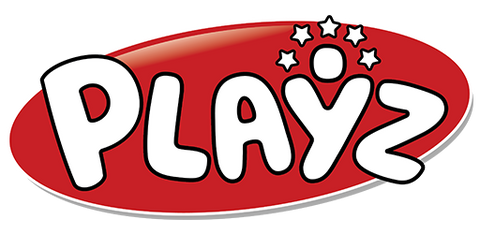
9 Engaging STEM Activities for Elementary Students in 2025
Welcome to a world of bubbling beakers, towering structures, and whirring robots! In an age driven by innovation, fostering a love for Science, Technology, Engineering, and Math (STEM) is more critical than ever. But how do we transform these complex subjects from intimidating textbook chapters into exciting, hands-on adventures? The answer lies in purposeful play and exploration.
This guide moves beyond generic ideas to provide a curated collection of proven and engaging STEM activities for elementary students. Each activity is designed to spark curiosity, build critical thinking skills, and show kids that learning can be the greatest adventure of all. We'll give you practical, step-by-step frameworks that turn any classroom or living room into a dynamic laboratory of discovery.
Forget abstract theories and dense explanations. Inside, you will find a treasure trove of projects complete with clear instructions, simple material lists, and actionable insights for educators and parents. We cover everything from engineering a bridge with household items and designing a functional water filter to exploring basic coding and concocting the perfect slime. Prepare to inspire the next generation of problem-solvers. Let's get building!
1. Building Bridges with Simple Materials
This classic engineering challenge is one of the most effective STEM activities for elementary students, transforming simple craft supplies into a dynamic lesson on structural integrity and design. Students use materials like popsicle sticks, straws, tape, and glue to design and construct bridges. The core objective is to build a structure that can support a specific amount of weight, teaching fundamental principles of physics and engineering in a tangible, hands-on way.
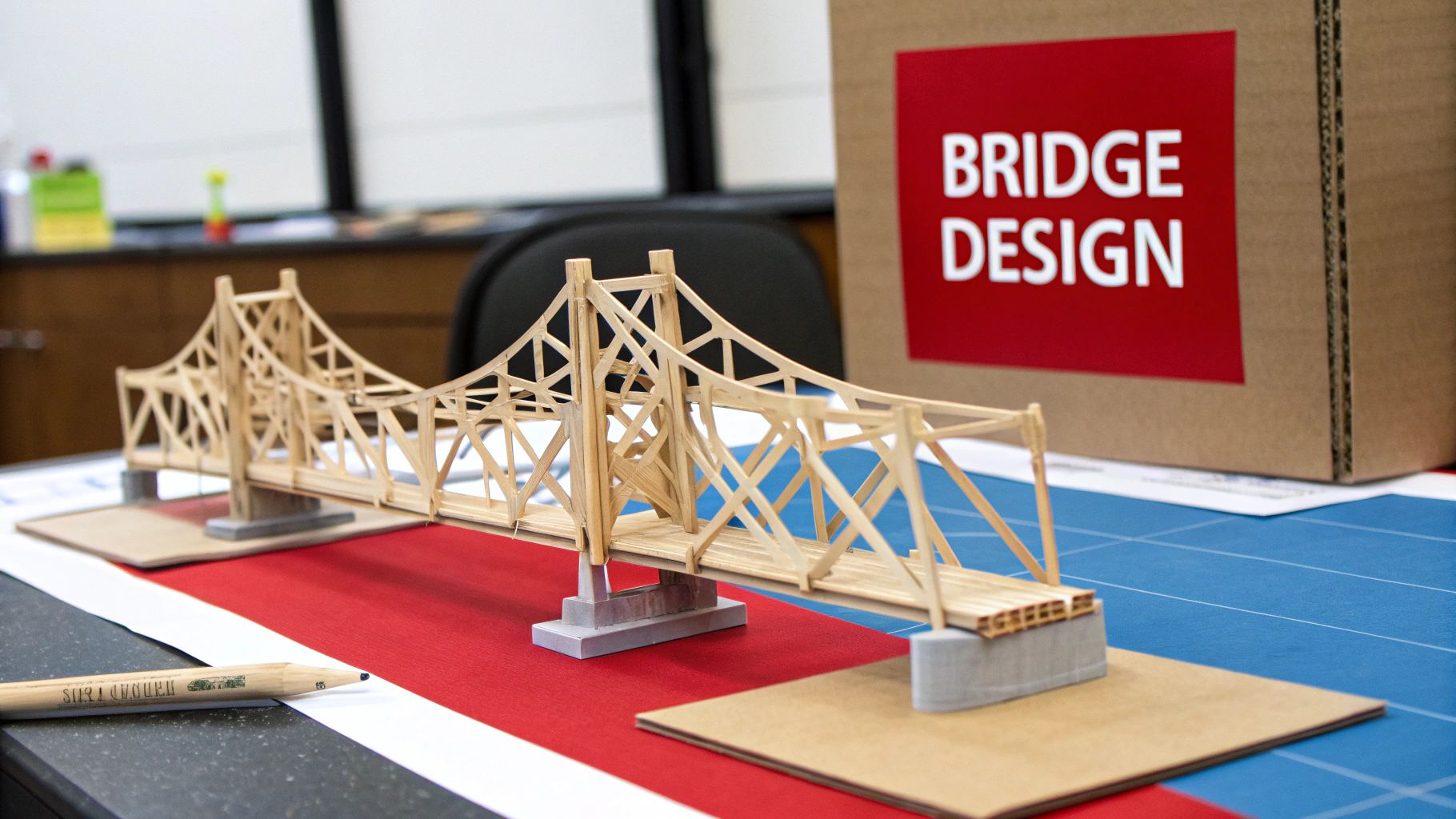
The activity encourages critical thinking and creative problem-solving as students experiment with different designs, like beam, arch, and truss bridges. Success stories from this activity are widespread; for instance, West Point Elementary's annual bridge-building competition led to a documented 40% increase in student interest in engineering clubs. This project makes abstract concepts like force distribution and tension immediately understandable.
How to Implement This Activity
To get started, provide each student or group with a design planning sheet to sketch their ideas before building. This encourages thoughtful construction over simple trial and error.
- Set Material Limits: Give each team the same type and quantity of materials. This constraint fosters resourcefulness and ensures a fair competition.
- Establish a Testing Protocol: Create a clear, standardized method for testing the bridges. Use uniform weights (like small books or cans of food) and a consistent testing area to measure how much load each bridge can withstand before failing.
- Encourage Reflection and Iteration: After testing, lead a discussion about why certain designs were more successful than others. Was it the use of triangles? The way the joints were secured? Documenting the process provides a great tool for this reflection and for planning improvements.
This activity is perfect for introducing engineering concepts because it scales easily for different age groups and skill levels. Younger students can focus on simple span bridges, while older students can tackle more complex truss designs and calculate efficiency ratios (weight held divided by bridge weight).
2. Egg Drop Challenge
This classic physics experiment is one of the most exciting STEM activities for elementary students, challenging them to design and build a protective container that can keep a raw egg from breaking when dropped from a height. The activity brilliantly introduces concepts like gravity, impact force, air resistance, and energy absorption. Students use everyday materials to engineer a solution, turning a simple premise into a memorable lesson on physics and creative design.
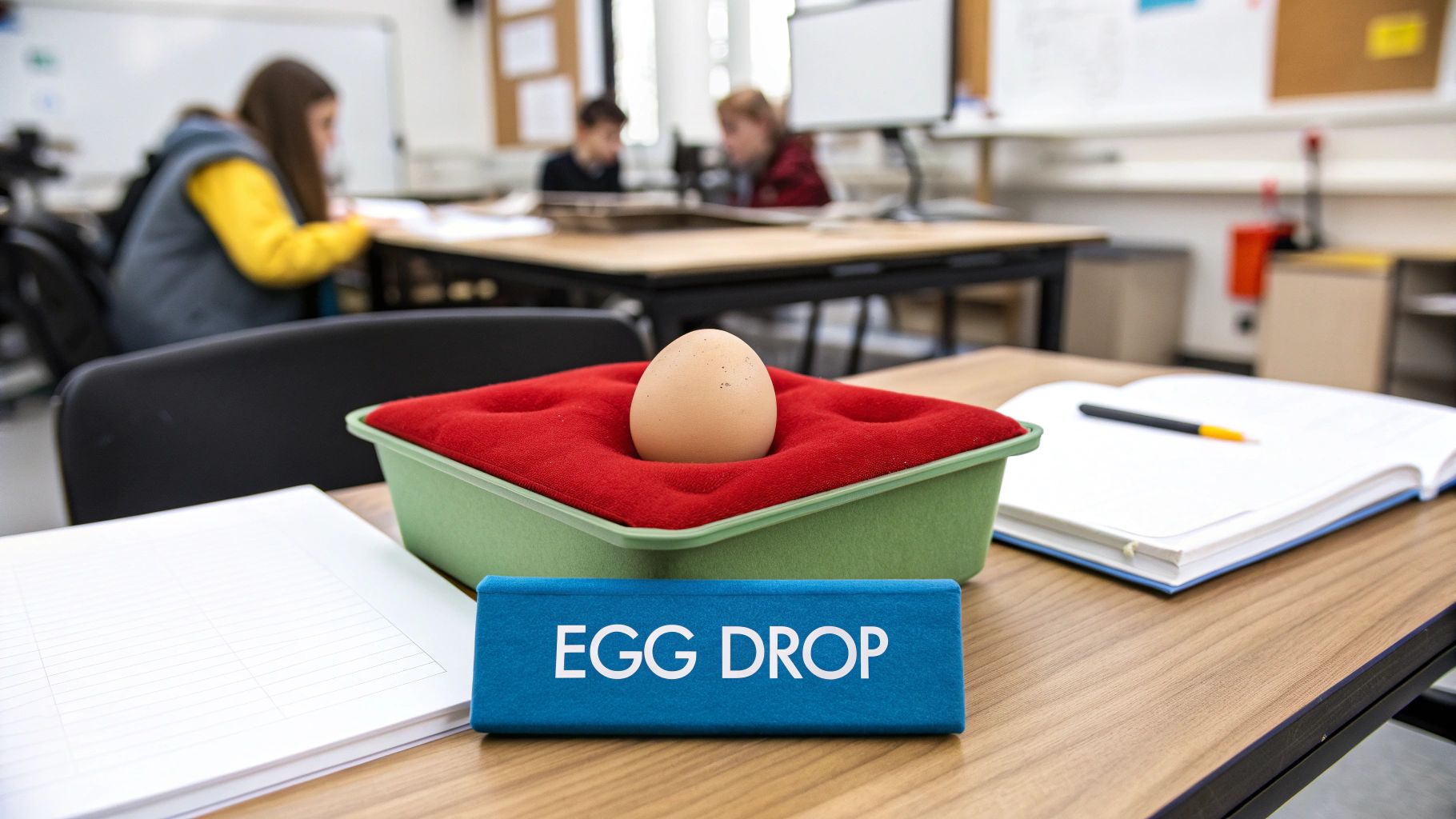
The challenge promotes ingenuity and iterative design as students develop unique contraptions. Its effectiveness is recognized by major organizations; NASA uses similar challenges in educational programs to teach principles of atmospheric entry for spacecraft, and the National Science Teachers Association (NSTA) often features it as a model hands-on activity. This project makes abstract physics concepts tangible and fun.
How to Implement This Activity
Begin by having students brainstorm and sketch their designs. This planning phase is crucial for encouraging them to think like engineers, considering how different materials and structures will absorb the shock of the impact.
- Offer Diverse Materials: Provide a wide array of supplies such as cardboard, straws, cotton balls, balloons, and tape. This variety allows for more creative and innovative solutions.
- Start Low, Go High: Begin with drops from a lower height, like a stepladder, and gradually increase the drop height. This incremental approach allows students to test and refine their designs based on performance.
- Facilitate a Post-Drop Debrief: After the drops, lead a discussion about what worked and what didn't. Analyze successful designs to identify key principles, such as creating a crumple zone to extend the time of impact or using a parachute to increase air resistance.
This activity is ideal for teaching the engineering design process because it naturally involves brainstorming, building, testing, and redesigning. For younger students, using plastic eggs can reduce mess and focus on the design aspect, while older students can calculate factors like velocity and potential energy.
3. Simple Coding with Scratch Jr.
ScratchJr introduces elementary students to the world of programming through an intuitive, visual interface. Developed by the MIT Media Lab and Tufts University, this platform allows children to create their own interactive stories and games by snapping together graphical programming blocks. This approach makes foundational coding concepts like sequencing, loops, and events accessible and fun, even for pre-readers.
This powerful tool bypasses the complexities of syntax-based languages, empowering students to become creators of technology, not just consumers. Its successful implementation is seen in major educational initiatives; for example, Chicago Public Schools integrated ScratchJr into their K-2 curriculum, and Singapore's national coding program uses it as a cornerstone. These programs highlight its effectiveness as one of the best digital STEM activities for elementary students.
How to Implement This Activity
To begin, familiarize students with the interface through a guided "tour," showing them the characters (sprites), backgrounds, and programming blocks. A simple first project, like making a character move across the screen and say "Hello!", can build initial confidence.
- Start with Storytelling: Encourage students to create a simple narrative. This connects coding to a familiar activity and gives their project a clear purpose and direction.
- Use Pair Programming: Have students work in pairs, with one "driver" controlling the tablet and one "navigator" suggesting the code. This fosters collaboration, communication, and problem-solving skills.
- Connect to Other Subjects: Integrate ScratchJr projects with other curriculum areas. For example, students can animate the life cycle of a butterfly for a science lesson or create a counting game for math. To further explore coding concepts without a computer, you can learn more about fun, screen-free coding puzzles.
- Host a Showcase: Set aside time for students to present their finished projects to the class. This celebrates their creativity and hard work, reinforcing the value of their learning.
This activity is ideal for introducing computational thinking because it provides immediate visual feedback, helping students understand the direct relationship between their code and the on-screen result.
4. Growing Crystals Science Experiment
This visually captivating chemistry experiment is a fantastic way to introduce concepts like crystallization, solubility, and molecular structure. Students create their own stunning crystal formations using simple household ingredients like salt, sugar, or borax, or by using a specialized kit. The process involves creating a supersaturated solution and allowing it to cool and evaporate slowly, which encourages dissolved particles to arrange themselves into a highly organized, repeating pattern, forming a crystal.
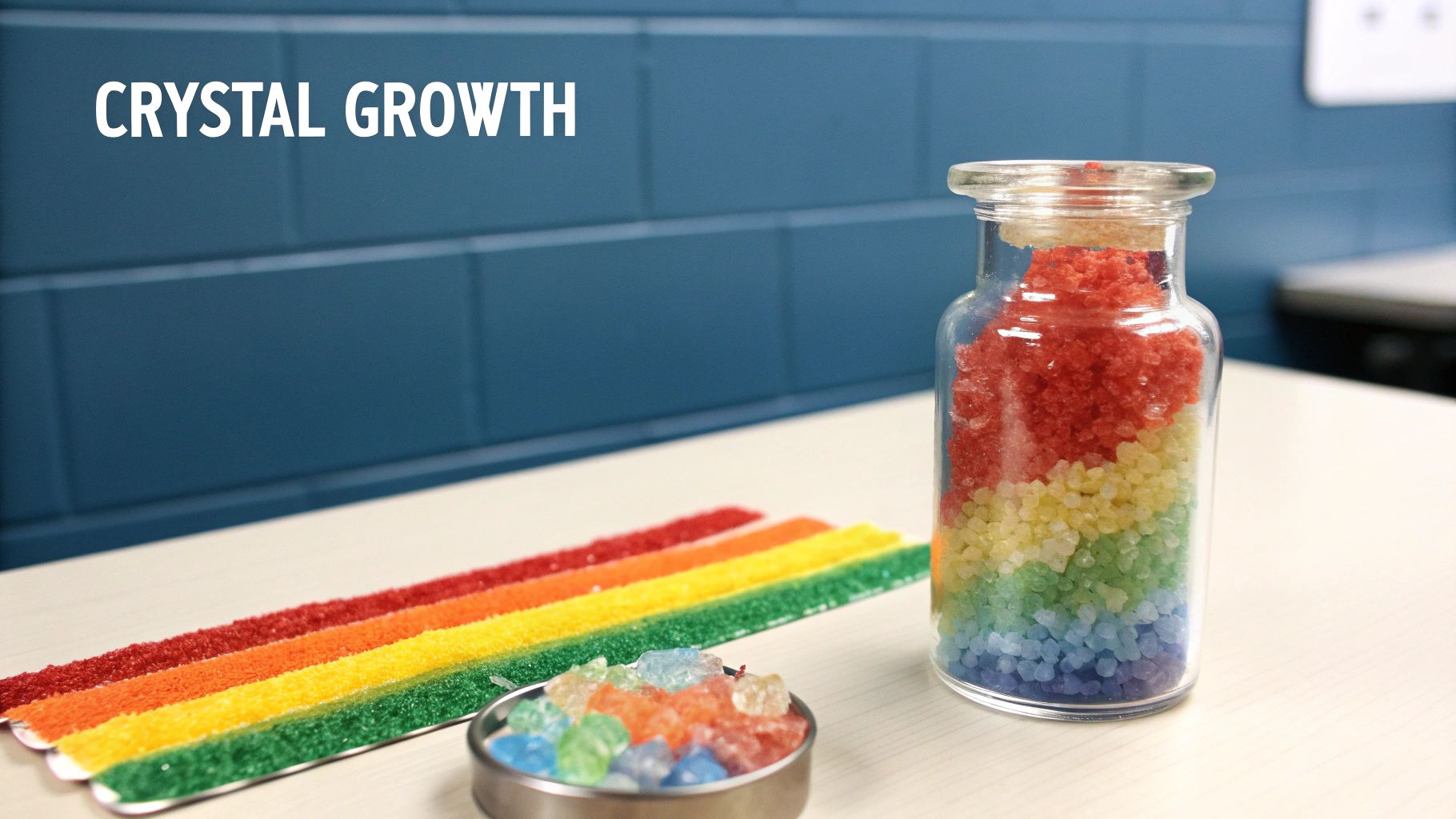
The slow, observable nature of crystal growth makes it one of the most rewarding stem activities for elementary students, teaching patience and careful observation. Success stories are common in educational settings; for example, the Smithsonian National Museum of Natural History incorporates crystal growing into its earth science programs to demonstrate geological processes. Similarly, many 4-H science projects feature crystal growing to teach the scientific method through long-term observation and data collection.
How to Implement This Activity
To begin, choose your crystal-growing medium (sugar, salt, and borax are excellent starting points). The key is creating a supersaturated solution where more solute is dissolved in a liquid than is normally possible.
- Prepare the Solution: Use distilled water for the clearest, most well-defined crystals. Heat the water to allow more solute to dissolve, and stir until no more will dissolve and some remains at the bottom.
- Set Up the Structure: Provide a surface for the crystals to grow on. Pipe cleaners bent into interesting shapes or a simple string suspended from a pencil across the top of a jar work perfectly.
- Encourage Scientific Journaling: Have students keep a detailed observation journal. They can sketch the crystal growth daily, take measurements, and note any changes, fostering scientific documentation skills.
This activity is ideal for teaching patience and the science of molecular formation. It can easily be connected to lessons about natural phenomena like the formation of geodes, caves, and snowflakes, providing a tangible link between a classroom experiment and the natural world. For those interested in a more guided experience, exploring a complete crystal growing kit on playzusa.com can offer a structured approach to this fascinating project.
5. Build Your Own Volcano
This iconic project is one of the most memorable STEM activities for elementary students, combining Earth science, chemistry, and hands-on creativity. Students construct a model volcano using materials like clay or paper-mache, then trigger a simulated eruption with a chemical reaction between baking soda and vinegar. The activity provides a powerful visual demonstration of geological processes and basic chemical reactions, making abstract concepts tangible and exciting.
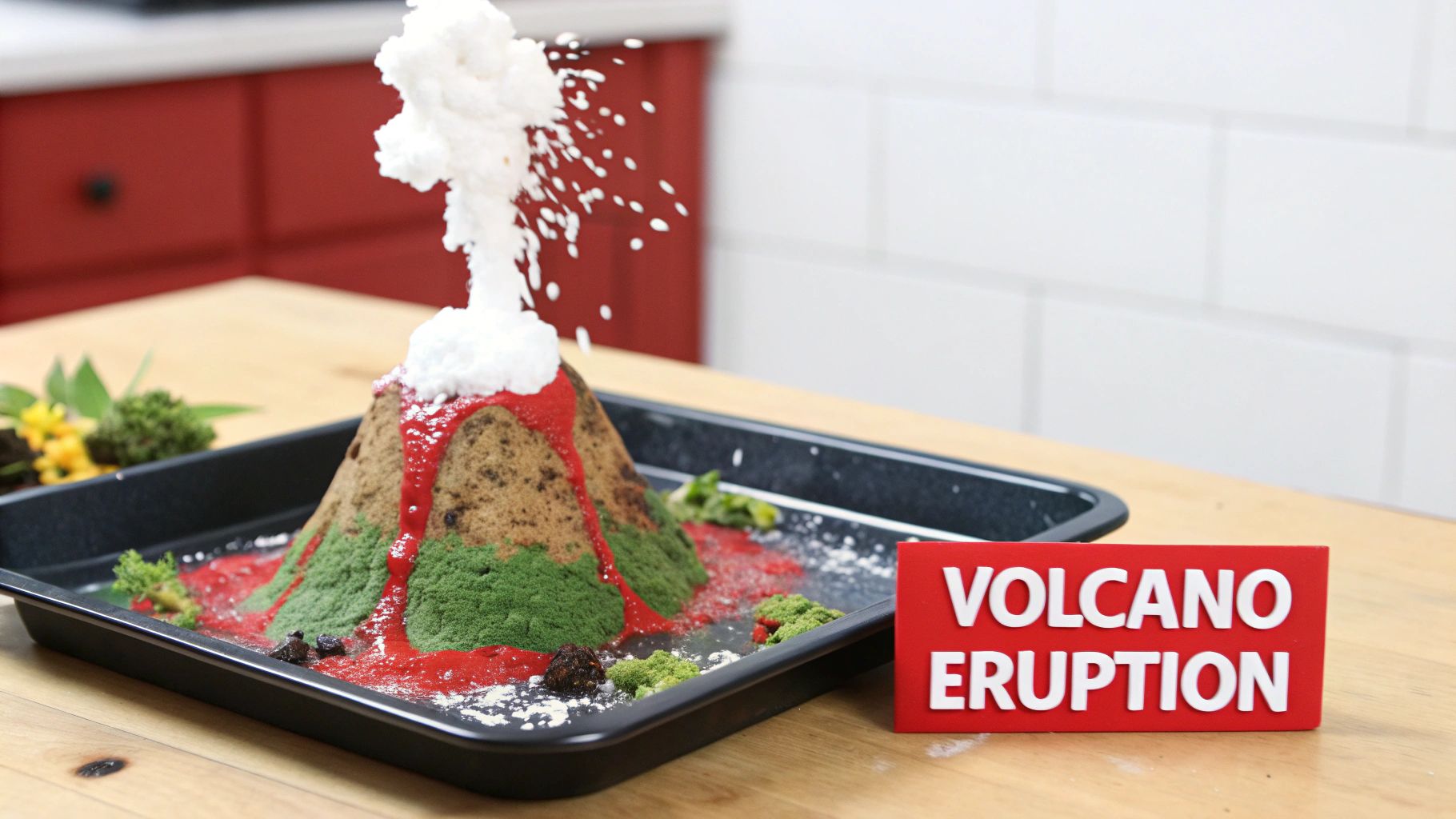
The volcano-building exercise encourages creative design while the eruption phase introduces scientific principles. This activity is a staple in many science curricula, with educators like Bill Nye the Science Guy popularizing it for its effectiveness. Many science museums and educational programs, including those featured by National Geographic, use this demonstration to teach Earth science concepts in an engaging way.
How to Implement This Activity
Start by having students build their volcano model around a small plastic bottle or container; this will hold the "magma" ingredients for a clean and controlled eruption.
- Enhance the Eruption: Add red or orange food coloring to the vinegar for a realistic lava color. A squirt of dish soap will trap the carbon dioxide gas produced, creating a foamier, more dramatic eruption.
- Encourage Scientific Observation: Guide students to measure and record data. Have them note the height of the eruption, the duration of the fizzing, and how different ingredient ratios affect the outcome.
- Connect to Real-World Science: Use the activity as a springboard to discuss real volcanoes, their locations along tectonic plates, and their impact on the environment and communities. This contextualizes the fun and deepens the learning.
This activity is ideal for introducing chemistry and geology because it provides immediate, visible results that spark curiosity. It serves as a fantastic foundation for exploring more complex topics like the rock cycle and plate tectonics. For more project ideas that build on these concepts, check out these 5th grade science experiments.
6. Robot Building with LEGO Education Sets
This activity elevates classic block-building into a comprehensive lesson in robotics and programming, making it one of the most dynamic STEM activities for elementary students. Using kits like LEGO Education WeDo or SPIKE Essential, students design, build, and program robots. The process seamlessly combines mechanical engineering with coding as they create machines that move, react to sensors, and complete specific tasks.
The activity fosters computational thinking and perseverance as students debug their programs and refine their mechanical designs. Its success is highlighted by global programs like the FIRST LEGO League competitions and its integration into national curricula, such as in Denmark. Carnegie Mellon's CREATE Lab also uses LEGO robotics to make computer science accessible to young learners, demonstrating its powerful educational impact.
How to Implement This Activity
To begin, introduce the basic components of the kit, including the motor, sensors, and the programming interface. A brief tutorial on the drag-and-drop coding blocks will empower students to start experimenting.
- Start with Guided Builds: Have students begin with the pre-designed models included in the kits. This helps them understand the fundamental building and programming concepts before they move on to free-building.
- Create Themed Challenges: Frame tasks around a story or a problem. For example, challenge students to build a "robot animal" that can move toward a light source (using a light sensor) or a "rescue bot" that can navigate a simple maze.
- Focus on the Process: Emphasize the iterative nature of robotics. Encourage students to predict what their code will do before running it and to discuss why their robot behaved differently than expected. This builds critical debugging skills.
This activity is ideal for introducing coding and engineering principles in a highly engaging format. It scales perfectly, allowing younger students to focus on simple cause-and-effect programs while older students can develop more complex, sensor-driven autonomous robots.
7. Solar Oven Construction and Testing
Harnessing the power of the sun, this activity is one of the most engaging STEM activities for elementary students, blending environmental science with hands-on engineering. Students use simple materials like a cardboard box, aluminum foil, black construction paper, and plastic wrap to design and build a functional solar oven. The goal is to create a device that traps solar energy to generate heat, demonstrating core principles of renewable energy, thermodynamics, and insulation.
This project allows students to see the direct application of scientific principles in a way that feels like magic: cooking with sunlight. It encourages creative problem-solving as they experiment with reflector angles and insulation techniques to maximize heat. Success stories, like those from educational programs by Solar Cookers International, show that students who build solar ovens gain a deeper, more memorable understanding of sustainable energy concepts.
How to Implement This Activity
To begin, challenge students to think about how they can best trap the sun's heat, providing them with a worksheet to sketch their design ideas before construction starts.
- Gather Simple Supplies: Provide each team with a pizza box or other cardboard box, aluminum foil, black paper, plastic wrap, tape, and a craft knife. This keeps the project accessible and low-cost.
- Establish a Delicious Goal: Set a clear objective, like melting chocolate for s'mores or warming up a small snack. This tangible, tasty outcome provides powerful motivation.
- Track and Measure: Equip each group with a thermometer to place inside their oven. Have them record the temperature at regular intervals to track their oven's performance and compare it to the outside air temperature.
This activity is perfect for introducing concepts like the greenhouse effect and solar radiation. Younger students can focus on the basic construction and the fun of cooking, while older students can explore variables like the angle of the sun, reflector size, and different types of insulation to optimize their designs.
8. Slime Science Laboratory
This gooey and engaging experiment is one of the most popular STEM activities for elementary students, turning a fun sensory experience into a memorable lesson on chemistry. Students mix common household ingredients like glue, water, and a borax solution to create their own slime. The core objective is to observe a chemical reaction in real-time, learning about polymers, viscosity, and the properties of non-Newtonian fluids in a hands-on, tactile way.
The activity captivates students' curiosity while demonstrating complex scientific concepts. As they mix the ingredients, they are creating polymer chains that give slime its unique texture. This concept has been widely popularized by educators like Steve Spangler and in Nickelodeon's educational programming, showing how a playful activity can spark genuine scientific inquiry and understanding of material science.
How to Implement This Activity
To get started, establish a designated "lab" area with covered surfaces and have all materials pre-measured and ready. This helps manage the mess and focuses students on the scientific process.
- Prioritize Safety and Cleanup: Begin with clear rules. Ensure students know not to taste the ingredients and have a plan for handwashing and surface cleaning.
- Encourage Experimentation: Provide different slime recipes or allow students to adjust ingredient ratios. Ask them to form a hypothesis about how changing an ingredient will affect the slime's texture. For fun variations, you can find kits like the Zombie Farts and Boogers Science Activity Set to add a gross-out factor.
- Compare and Contrast: Have groups make different types of slime (e.g., fluffy, clear, magnetic) and then compare their properties. This encourages observation, data collection, and communication skills as they describe the differences in stretchiness, bounciness, and flow.
This activity is perfect for introducing chemistry because it provides immediate, tangible results. It connects abstract concepts like molecular bonding to a physical substance students can touch and manipulate, making it an unforgettable learning experience.
9. Water Filtration System Design
This engaging activity challenges students to become environmental engineers by designing and building their own water filtration systems. Using simple materials like plastic bottles, sand, gravel, cotton balls, and coffee filters, students learn firsthand about water purification. The goal is to take a sample of "dirty" water (like muddy water) and make it visibly cleaner, introducing core concepts of environmental science and the importance of clean water.
This hands-on project connects directly to real-world problems, teaching the science behind how natural resources like sand and gravel can clean our water. Educational programs from the Environmental Protection Agency (EPA) often feature similar experiments to raise environmental awareness. One school district even saw students initiate a school-wide water conservation campaign after completing this project, showing its real-world impact.
How to Implement This Activity
To begin, prepare a batch of dirty water (e.g., soil, leaves, and water mixed in a bucket) that students will use for testing. This provides a consistent baseline for all filtration designs.
- Layer the Materials: Encourage students to think critically about the order of their filter layers. Should coarse gravel go on top or bottom? Why? This step promotes planning and hypothesis testing.
- Measure and Compare: Before and after filtering, have students observe and record the water's clarity. They can use a simple turbidity scale or take photos to document the change.
- Discuss Global Context: Use this activity as a springboard to discuss global water access issues. Connect their small-scale filter to the large-scale challenges faced by communities worldwide, using resources from organizations like Water.org.
This activity is one of the most impactful stem activities for elementary students because it blends earth science, engineering, and social studies. It’s easily adaptable, allowing younger students to focus on the basic filtering process while older students can incorporate materials like activated charcoal and test for pH changes.
9 STEM Activities Comparison Matrix
| Activity | Implementation Complexity 🔄 | Resource Requirements ⚡ | Expected Outcomes 📊 | Ideal Use Cases 💡 | Key Advantages ⭐ |
|---|---|---|---|---|---|
| Building Bridges | Moderate (hands-on building, testing) | Low (inexpensive, everyday materials) | Demonstrates engineering principles, load testing | STEM clubs, classroom projects K-5 | Encourages creativity, teamwork, low cost |
| Egg Drop Challenge | Moderate (design, build, test drops) | Low to Moderate (varied cushioning materials) | Physics principles applied, impact testing | Physics lessons, outdoor activities | Highly engaging, clear success criteria |
| Simple Coding | Low (software-based, visual blocks) | Moderate (requires devices/tablets) | Early computational thinking, creativity growth | Early programming education K-2 | No reading needed, encourages storytelling |
| Growing Crystals | Low to Moderate (setup, long observation) | Moderate (solutions, kits) | Demonstrates chemistry and crystallization | Long-term projects, chemistry units | Visually impressive, teaches patience |
| Build a Volcano | Moderate (construction and chemistry) | Low to Moderate (household materials) | Geological and chemical reaction understanding | Earth science units, art integration | Highly engaging, integrates multiple disciplines |
| Robot Building | High (building + programming) | High (LEGO sets, devices) | Engineering and programming skills | Robotics clubs, advanced STEM classes | Comprehensive support, iterative design |
| Solar Oven | Moderate (construction + testing) | Low (recyclable, common materials) | Renewable energy concepts and heat transfer | Environmental science units | Demonstrates practical sustainability |
| Slime Science | Low (recipe following) | Low (common household chemicals) | Polymer chemistry, sensory engagement | Hands-on chemistry, sensory learning | Popular, immediate results, tactile experience |
| Water Filtration | Moderate (design, setup, testing) | Moderate (common + specialized materials) | Environmental engineering and water purification | Environmental STEM, global issues | Real-world impact, develops engineering skills |
Your Mission: Launch a Lifelong Love of Learning
The journey through these nine engaging projects, from engineering structurally sound bridges to coding a simple animation, is about much more than just completing a checklist of activities. Each experiment serves as a crucial building block in constructing a child's confidence, critical thinking skills, and fundamental understanding of how the world works. You've seen how simple household items can transform into powerful teaching tools, and how a challenge like the classic egg drop can impart profound lessons in physics and resilience.
The true value of these stem activities for elementary students lies not in achieving a perfect outcome, but in embracing the process of discovery. A bridge that collapses is not a failure; it’s an invaluable data point for the next iteration. A crystal-growing experiment that takes an unexpected turn becomes a lesson in patience and observation. These hands-on experiences demystify complex scientific principles, making them accessible, tangible, and, most importantly, fun.
The Power of Playful Problem-Solving
Think back to the activities we explored. The Solar Oven construction didn't just teach about renewable energy; it demonstrated the scientific method in action—hypothesizing, building, testing, and refining. The LEGO Education robot project went beyond simple assembly, introducing foundational concepts of automation and programming. Each activity was designed to encourage a "what if?" mindset.
The key takeaway is this: STEM is not a subject to be memorized, but a way of thinking to be cultivated. By facilitating these explorations, you are empowering children with a versatile toolkit for life. They learn to:
- Ask insightful questions: "Why did my water filter get clogged?"
- Collaborate and communicate ideas: "What if we use more cotton balls in our design?"
- Persevere through challenges: "The first volcano eruption was small. Let's adjust the baking soda and vinegar ratio."
- Connect concepts to the real world: "This bridge uses triangles for support, just like the big bridge we drive over!"
Your Next Steps in the STEM Adventure
The momentum from one successful experiment can fuel a child's curiosity for weeks. Your role is to keep that momentum going. Don't let this list be the end of your journey. Use it as a launchpad.
Observe which activities sparked the most excitement. Was it the chemistry of slime-making or the engineering of the water filtration system? Use that enthusiasm as a guide for what to try next. The goal is to nurture an environment where asking questions is celebrated and experimentation is the norm. By consistently providing these opportunities for hands-on exploration, you are not just teaching science—you are fostering the next generation of innovators, engineers, and creative problem-solvers who will shape our future. The messes will wash away, but the thrill of discovery will last a lifetime.
Ready to take the next step without the hassle of sourcing materials? Playz offers a wide range of all-in-one science kits and creative toys designed to make learning an unforgettable, hands-on adventure. Continue the journey and empower the next generation, one playful experiment at a time, by exploring the award-winning collection at Playz.
Article created using Outrank
